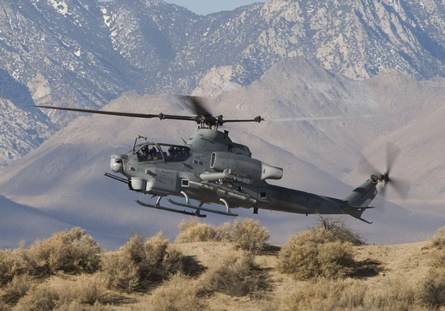After months of work to correct deficiencies, the US Marine Corps' upgraded Bell AH-1Z attack and UH-1Y utility helicopters have begun the second and final phase of operational evaluation.
Opeval Phase 2 began at the US Navy's test centre at China Lake in California on 11 February and is scheduled to last for 90 days. This is a crucial hurdle for the H-1 upgrade programe, which had to be restructured after suffering schedule delays and cost overruns.
H-1 programme manager Col Keith Birkholz says eight deficiencies identified during the first phase of operational testing at the end of 2006 have been remedied. These included malfunctions of the Lockheed Martin electro-optical/infrared target sight system.

© US Navy
The Thales Top Owl visor-projected helmet-mounted display was deferred because of a visual anomaly called hyperstereopsis, which made it unsafe to use when flying close to ground. Instead head-up information is projected on a monocular display or night-vision goggles.
Issues with the health and usage monitoring system have been overcome, says Birkholz, while the latest software load incorporates several fixes. Other deficiencies corrected involve auxiliary power unit hot starts, tail rotor blades and chip detectors.
"Overall, we expect to get a satisfactory grade" from opeval Phase 2, he says. There is one outstanding issue, which the AH-1Z shares with the US Army's Boeing AH-64D attack helicopter - rocket gas ingestion by the General Electric T700 engines.
"This is similar to the Apache issue, the same type of micro compressor stall," says Birkholz. "It's a small ripple through the drive system that's not noticeable except on flight-test instrumentation. It's not fixed yet, but we are working on it."

© US Navy
The US Marine Corps has time to work on a fix because the upgraded AH-1Z will not become operational until 2011, while the UH-1Y is scheduled for initial operational capability in September of this year, ready for deployment early in 2009.
The AH-1Z was deferred and UH-1Y accelerated because USMC needs to replace its UH-1Ns as fast as possible, says Birkholz.
The N has a gross weight of 10,500lb and can carry little payload in the hot and high conditions of Iraq and Afghanistan. Re-engined with T700s and fitted with a four-blade rotor, the Y has a gross weight of 18,500lb, doubling the UH-1's range and payload, he says.
Although the H-1 upgrade began as a remanufacturing effort, Bell is building almost all of the 100 planned UH-1Ys as new aircraft and has received a contract for the engineering to produce new-build AH-1Zs.
Birkholz says the expected attrition of AH-1Ws means there will not be enough airframes to remanufacture, so the final 40 of the planned 180 AH-1Zs will built new. With the US Marine Corps increasing in size, this also means it will be able to buy more H-1s as required, Birkholz says.

© US Navy
Source: FlightGlobal.com
















